
Syzygium is a genus of flowering plants that belongs to the myrtle family, Myrtaceae. The genus comprises about 1200 species, and has a native range that extends from Africa and Madagascar through southern Asia east through the Pacific. Its highest levels of diversity occur from Malaysia to northeastern Australia, where many species are very poorly known and many more have not been described taxonomically.

Backhousia is a genus of thirteen currently known species of flowering plants in the family Myrtaceae. All the currently known species are endemic to Australia in the rainforests and seasonally dry forests of Queensland, New South Wales and Western Australia.
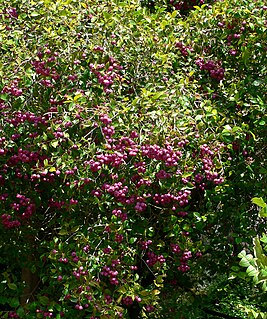
Syzygium smithii is a summer-flowering, winter-fruiting evergreen tree, belonging to the myrtle family Myrtaceae. It shares the common name "lilly pilly" with several other plants. In New Zealand, it is commonly known as 'monkey apple'. It is planted as shrubs or hedgerows, and features: rough, woody bark; cream and green smooth, waxy leaves; flushes of pink new growth; and white to maroon edible berries. Unpruned, it will grow about 3–5 m (9.8–16.4 ft) tall in the garden.
Acmena was formerly the name of a genus of shrubs and trees in the myrtle family Myrtaceae. The genus was first formally described in 1828 by Augustin Pyramus de Candolle in his Prodromus Systematis Naturalis Regni Vegetabilis.

Syzygium anisatum, with common names ringwood and aniseed tree, is a rare Australian rainforest tree with an aromatic leaf that has an essential oil profile comparable to true aniseed.
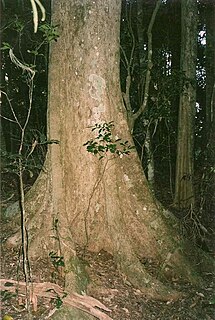
Syzygium crebrinerve is a fairly common Australian tree, growing from near Taree, New South Wales to Calliope in Queensland. Common names include purple cherry, rose satinash, and black water gum. The habitat of Syzygium crebrinerve is sub tropical rainforest on basaltic or fertile alluvial soils.

Syzygium hemilamprum, commonly known as the broad-leaved lilly pilly, blush satinash, cassowary gum, Eungella gum, and treated as Acmena hemilampra in New South Wales and Queensland, is a species of flowering plant in the family Myrtaceae and is native to New South Wales, Queensland and the Northern Territory. It is a rainforest tree with broadly lance-shaped to elliptic leaves, panicles of white flowers and more or less spherical white fruit.

Melaleuca williamsii is a plant in the myrtle family, Myrtaceae and is endemic to an area between north-eastern New South Wales and south eastern Queensland in Australia. It is a distinctive shrub with stiff branches, silvery new growth, prickly leaves and spikes of purple flowers in late spring. It is classified as a vulnerable species under the Australian Government Endangered Species Protection Act.

Melaleuca orophila, commonly known as needle bottlebrush or Flinders Ranges bottlebrush, is a plant in the myrtle family, Myrtaceae and is endemic to the eastern part of South Australia.. It is a medium-sized shrub with sharp-pointed, needle-like leaves and bright red bottlebrush flower spikes.

Melaleuca recurva, commonly known as Tinaroo bottlebrush, is a plant in the myrtle family, Myrtaceae and is endemic to higher areas of far northern Queensland in Australia.. It is a shrub with spikes of red flowers tipped with yellow in most months of the year and which often has leaves with their edges curled under.
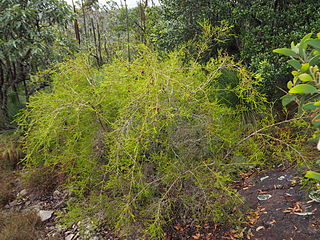
Melaleuca uxorum is a plant in the myrtle family Myrtaceae and is endemic to the northern Herberton Range in far north Queensland. It is a newly described (2004) species similar to Melaleuca sylvana and Melaleuca monantha, also from far north Queensland.

Melaleuca faucicola commonly known as desert bottlebrush, is a plant in the myrtle family, Myrtaceae and is endemic to the Northern Territory in Australia. It is a shrub or small tree growing only in protected gorges in the ranges of Central Australia such as the Petermann Ranges and has red, cream or white spikes of flowers.
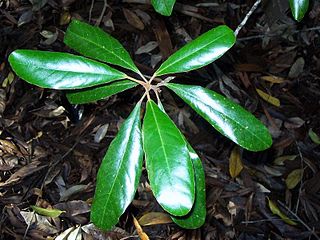
Elaeocarpus williamsianus, commonly known as hairy quandong, is a species of flowering plant in the family Elaeocarpaceae and is endemic to a restricted area of north-eastern New South Wales. It is a small tree with lance-shaped leaves, racemes of greenish-white flowers and spherical blue fruit.

Melaleuca pallida, commonly known as lemon bottlebrush, is a plant in the myrtle family, Myrtaceae and is endemic to eastern Australia. It is an upright shrub with thin, spreading branches, silvery new growth and pale yellow, sometimes pinkish bottlebrush flowers.
Melaleuca ferruginea is a plant in the myrtle family, Myrtaceae and is endemic to areas near the coast of the Northern Territory in Australia. It grows to tree size, its new bark is reddish-brown and papery, and its flowers are arranged in spikes new the ends of its branches.
Melaleuca hemisticta, commonly known as Mount Wheeler bottlebrush is a plant in the myrtle family, Myrtaceae and is endemic to coastal areas of Queensland. It is a tall, bushy shrub with dark green leaves and red flowers spikes tipped with yellow.

Melaleuca rugulosa, commonly known as scarlet bottlebrush, is a plant in the myrtle family, Myrtaceae and is endemic to South Australia and Victoria in Australia. It is a shrub with an open straggly habit, stiff, sharply pointed leaves and bright red bottlebrush flowers tipped with yellow in summer.
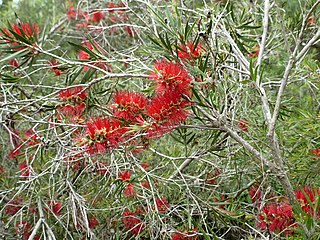
Melaleuca sabrina is a plant in the myrtle family, Myrtaceae and is endemic to a small area near the border between New South Wales and Queensland in Australia. It is a shrub with fibrous bark and red or pink bottlebrush flowers, tipped with yellow in spring and summer. It is similar to Melaleuca paludicola but distinguished from it by its stamens, which are almost twice as long as those of M. paludicola.

Syzygium claviflorum is a tree in the Myrtaceae family. It is native to the north of the Australian continent and in tropical and subtropical Asia. It is used for timber, as fuel, as human and cattle food, and for dye. Stunted specimens can be found on the top of the plateau of Bokor National Park, Cambodia.
Syzygium apodophyllum is a tree in the Myrtaceae family endemic to north Queensland. The fruit is edible. It is a host for the exotic plant-pathogen fungus Austropuccinia psidii, which is causing a lot of damage to vegetation communities and economic plants.

















